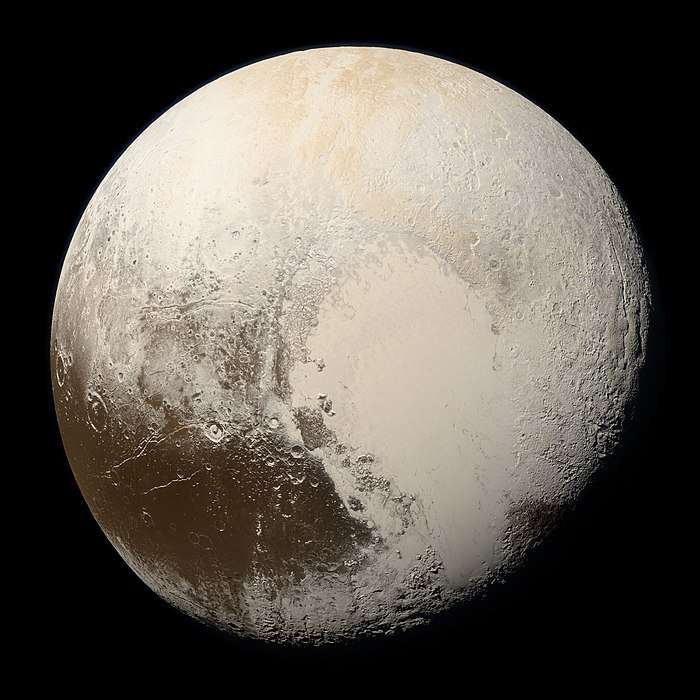(455502) 2003 UZ413
(455502) 2003 UZ413, also written as 2003 UZ413, is a trans-Neptunian object (TNO) with an absolute magnitude of 4.38.[5] It is in a 2:3 orbital resonance with Neptune, thus it is classified as a plutino.[3] It is likely large enough to be a dwarf planet.[11] It was given the minor planet number 455502 on 22 February 2016.[12]
 Hubble Space Telescope image of 2003 UZ413 taken in 2008 | |
| Discovery[1] | |
|---|---|
| Discovered by | M. E. Brown D. L. Rabinowitz C. A. Trujillo |
| Discovery date | 21 October 2003 |
| Designations | |
| 2003 UZ413 | |
| TNO[2] · plutino[3][4][lower-alpha 1] | |
| Orbital characteristics[2] | |
| Epoch 27 April 2019 (JD 2458600.5) | |
| Uncertainty parameter 2 | |
| Observation arc | 63.25 years (23103 days)\ |
| Earliest precovery date | 29 July 1954 |
| Aphelion | 47.968 AU (7.1759 Tm) |
| Perihelion | 30.241 AU (4.5240 Tm) |
| 39.104 AU (5.8499 Tm) | |
| Eccentricity | 0.22667 |
| 244.54 yr (89317.3 d) | |
| 113.43° | |
| 0° 0m 14.51s / day | |
| Inclination | 12.04911° |
| 135.930° | |
| 145.00° | |
| Physical characteristics | |
| Dimensions | 650+1 −175 km (upper limit)[5] 472+122 −25 km (lower limit)[5] |
| Mass | ≈3×1020 kg[lower-alpha 2] |
Mean density | 2.29–3.00 > ρ >0.72 g/cm3[6] 2.64 g/cm3[7] |
Sidereal rotation period | 4.13±0.05 h[6][8] 4.14 h[2] |
| 0.075+0.076 −0.006 (lower limit)[5] 0.151+0.025 −0.064 (upper limit)[5] | |
| V–R=0.45±0.04[5] BB taxon (blue/neutral)[7][9][lower-alpha 3] V−R=0.46±0.06 R−I=0.37±0.06[9] | |
| 21[10] | |
| 4.38±0.05[5] 4.3 (assumed)[2] | |
It has been observed 79 times over 15 oppositions, with precovery images back to 27 July 1954.[2]
Orbit and rotation

2003 UZ413 is in a 2:3 resonance with Neptune, which means that when it makes two revolutions around the Sun, Neptune makes exactly three.[3]
The object rotates very fast. In fact, with a period of about 4.13 hours, it is the fastest rotator known in the Kuiper belt after Haumea.[6][8]
Physical characteristics
The mean diameter of 2003 UZ413 is estimated to be 650+1
−175 km, if it has a low albedo.[5]
Given its rapid rotation, it must have a density higher than 0.72 g/cm3.[6] Stable Jacobi ellipsoids with an axis ratio of a/b ≥ 1.13±0.03, as implied by its light-curve amplitude of Δm = 0.13±0.03, exist for densities in the range of 2.29−3.00 g/cm3.[6] The Johnston's Archive settles on 2.64 g/cm3,[7] the centre of the latter range; for a 600 km equivalent spheroid body, this would equate to a mass of approximately 3.0×1020 kg. The relatively high estimated density (in stark contrast to many similarly sized TNOs)[13] increases the chance that the object has no internal porosity and has collapsed into hydrostatic equilibrium (a requirement of being certified as a Dwarf Planet), but confirmation of this hypothesis requires observations to refine the size and light curve details, preferably with determination of the orbit of any satellite that may exist.
In visible light, this object is neutral or slightly red in color and has a flat, featureless reflectance spectrum.[8]
Notes
- Buie page actually says 3:2 resonance... thus, also "Plutino"
- very approximate figure, assuming equivalent spherical diameter of ≈600 km and density ≈2.64 g/cc3
- equivalent to V-I=0.75±0.06, B-V=0.68±0.06 and V-R=0.39±0.05
References
- Brown, M.; Trujillo, C.; Rabinowitz, D.; Marsden, B. G. (2007-09-01). "2003 UY413, 2003 UZ413, 2004 NT33, 2005 CA79, 2005 CB79, 2005 UQ513". Minor Planet Electronic Circulars: 02. Bibcode:2007MPEC....R...02B. MPEC 2007-R02.
- "JPL Small-Body Database Browser: (2003 UZ413)" (last observation: 2017-10-29). Retrieved 19 August 2019.
- Marsden, B. G. (2008-07-17). "Distant Minor Planets". Minor Planet Electronic Circulars. Bibcode:2008MPEC....O...05B. MPEC 2008-O05. Retrieved 3 December 2010.
- Marc W. Buie (2015-09-24). "Orbit Fit and Astrometric record for 2003 UZ413". SwRI (Space Science Department). Archived from the original on 2015-09-23. Retrieved 2019-08-19.
- Farkas-Takács, A.; Kiss, Cs.; Vilenius, E.; Marton, G.; Müller, T. G.; Mommert, M.; et al. (28 February 2020). "TNOs are Cool! A Survey of the transneptunian Region XV. Physical characteristics of 23 resonant transneptunian and scattered disk objects". arXiv:2002.12712 [astro-ph.EP].
- Perna, D.; Dotto, E.; Barucci, M. A.; Rossi, A.; Fornasier, S.; de Bergh, C. (2009). "Rotations and densities of trans-Neptunian objects". Astronomy & Astrophysics. 508 (1): 451–455. Bibcode:2009A&A...508..451P. doi:10.1051/0004-6361/200911970. Retrieved 1 June 2019.
- William Robert Johnston. "List of known trans-Neptunian objects". Johnston's Archive. Retrieved 2019-08-19.
- Fornasier, S.; Barucci, M. A.; de Bergh, C.; Alvarez-Candal, A.; Demeo, F.; Merlin, F.; Perna, D.; Guilbert, A.; Delsanti, A.; Dotto, E.; Doressoundiram, A. (2009). "Visible spectroscopy of the new ESO large programme on trans-Neptunian objects and centaurs: Final results" (PDF). Astronomy and Astrophysics. 508 (1): 457–465. arXiv:0910.0450. Bibcode:2009A&A...508..457F. doi:10.1051/0004-6361/200912582.
- Perna, D.; Barucci, M.A.; Fornasier, S.; et al. (2010). "Colors and taxonomy of centaurs and trans-Neptunian objects". Astronomy and Astrophysics. 510: A53. arXiv:0912.2621. Bibcode:2010A&A...510A..53P. doi:10.1051/0004-6361/200913654.
- "2003 UZ413 Ephemerides". Asteroids Dynamic Site. Archived from the original on 2019-08-19. Retrieved 2019-08-19.
- Mike Brown (30 May 2019). "How many dwarf planets are there in the outer solar system?". Mike Brown's Planets. Caltech Division of Geological and Planetary Sciences. Archived from the original on 31 May 2019. Retrieved 19 August 2019.
- "(455502) 2003 UZ413 Precovery Images". Andrew Lowe's Minor Planet. Retrieved 28 April 2019.
- Grundy, W.M.; Noll, K.S.; Buie, M.W.; Benecchi, S.D.; Ragozzine, D.; Roe, H.G. (December 2019). "The Mutual Orbit, Mass, and Density of Transneptunian Binary Gǃkúnǁʼhòmdímà ((229762) 2007 UK126)". Icarus. 334: 30–38. doi:10.1016/j.icarus.2018.12.037. Archived from the original on 2019-04-07. Retrieved 2019-11-06.
_(cropped).jpg)
